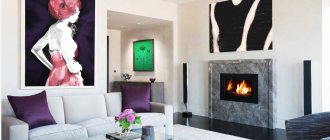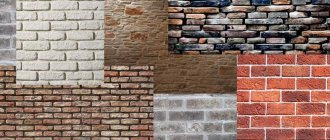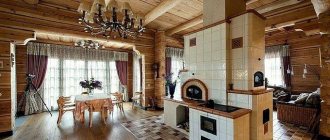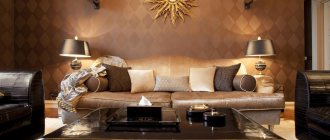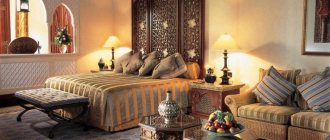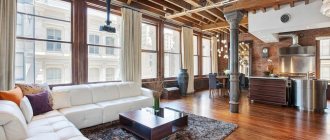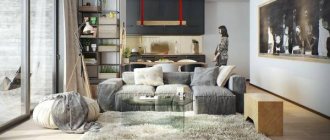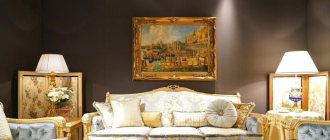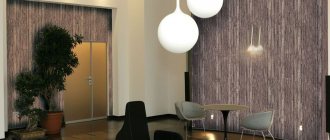The Arab East became incredibly popular in Europe after the publication of translations of the Arabian Nights fairy tales at the very beginning of the 18th century. However, residents of the Old World became acquainted with “overseas” interior items and precious fabrics from Iraq and Syria long before this.
They were brought with them by the crusaders returning from Palestine.
Such curiosities cost fabulous amounts of money and decorated the homes of only the most noble and wealthy nobles.
And today, only people who are ready for high financial expenses choose the authentic Arabic style in the interior.
The result is a status design that evokes admiration.
This article will tell you what an Arabic-style interior should be like.
Arabic style in the interior: Who is it suitable for?
Designers advise choosing a home design option based not only on your taste preferences, but also on your family’s lifestyle.
The Arabic style in the interior suits a respectable, respectable couple with high social status who loves bright colors and comfort. However, it can also be chosen by successful young people from a bohemian environment.
Main features of the style
This style does not allow for uncluttered surfaces - absolutely everything is decorated with a pattern.
It is not permissible to place paintings depicting plants, people, or animals in the house.
The painting is a strange, outlandish pattern, which consists of various kinds of phrases of the Holy Quran, and is decorated with ornaments.
The highlight of the pattern used is the clarity of the lines with a description of each detail. Arabesque is made in bright and rich colors, for example, black, scarlet, emerald, crimson.
Arabic style in the interior: Furniture
Since we are talking about furniture, let’s say that the authentic Arabic style in the interior involves the rejection of many pieces of furniture that are familiar to a European.
As you know, once at home after long treks through the desert, the Arabs preferred to spend their leisure time lounging on a low sofa and smoking a hookah.
The sofa came to Europe from Turkey. However, it was widespread throughout the Ottoman Empire, which occupied most of the Middle East region.
Traditional types of furniture characteristic of Arabic interiors also include:
- bedside tables and stools, hexagonal in shape, decorated with carvings;
- small, low cabinets with lattice or openwork doors;
- soft ottomans;
- etc.
The Arabic style in the interior can also be emphasized using screens. They should be wooden with openwork carvings in the form of arabesques. This piece of furniture is a real find if you need to zone a room.
The use of man-made products in the oriental interior
The Arabian interior is filled with handicrafts. First of all, these are carpets. The cost of one hand-made carpet, especially a silk one, can be several tens of thousands of dollars. These are real works of art.
Not everyone can afford a real rug, so buy a cheaper product, as long as it doesn't look too modern or so synthetic that it immediately catches your eye.
Wooden oriental mosaics, made from pieces of wood of regular geometric shapes and assembled in the form of various patterns, decorate niches, cabinets, shelves, columns, and walls.
The mosaic base is painted in traditional Arabic colors, and the ornament itself is covered with mother-of-pearl.
Inlays are applied to all pieces of furniture and any surfaces in the room. It is made of gold, bronze, ivory. The recesses are most often filled with blue paint.
Arabic style in the interior: Textiles
Many fabrics that are still used to decorate interiors today came to the Old World from Syria, Iraq, Morocco and neighboring countries. For example, this is Mosul muslin, Moroccan Moroccan or Damask silk.
In addition, the Arabic style in the interior involves the use of carpets. They cover not only the floor, but also sofas and couches. Often the carpet is used as a tablecloth. On carpets, even on the floor, there are many pillows of different shapes, including in the form of bolsters. They are decorated with galloons and tassels.
An important part of the Arabic interior is the canopy. It is a native Middle Eastern invention. Initially, they were used in harems and other premises of Arab rulers, in order to hide the concubines and wives of the emir or his nobles from prying eyes.
What is Arabic interior
Arabian interior is a room design style that was invented to decorate the homes of residents of Turkey, the United Arab Emirates, Afghanistan, Syria and other Middle Eastern countries.
This interior is luxurious and flashy. In the rooms, furnished in the traditions of the Arabic style, everything breathes with wealth and imposingness, and the objects are beautiful in shape and bright in color.
It is preferable to use natural finishing materials: satin, wood, stone, silk and others. But forged, gilded, and silver-plated elements are also introduced.
Finishing
If you want to recreate the Arabic style in the interior, you can use the simplest decoration of the walls and ceiling. They can simply be plastered white and the floor covered with carpets. Bright carpets, curtains and decorative items will look great against such a neutral background.
Another option is also possible. You can use the palace Arabic style in the interior. It involves the use of small ceramic tiles and mosaic wall decoration.
If you like such “variegated” walls with arabesques, be careful when choosing textiles. It is better that curtains, carpets and upholstery of upholstered furniture are plain. Otherwise, the interior will be tasteless and quickly get boring.
Kitchen finishing
The walls or just the apron are covered with ceramic tiles. Emerald, turquoise, blue or yellow patterns on a light background. The floor has light tiles with blue drops.
There is a ceramic surface and arabesque on the table, next to it there are wooden carved chairs upholstered in beige fabric. As an addition - an Arabic tea set, ceramic dishes and vases.
Modern Arabic style in the interior
Authentic Arabic style in the interior of small apartments rarely looks good. However, if you really want to have such a design for your living room, bedroom, bathroom or kitchen, choose an eclectic option.
You can create a minimalist monochrome design in your home and give it an Arabic touch. For this purpose, it is enough to use a couple of original authentic parts. This could be an original lamp, a carpet with bright arabesques, a vase or a hookah. A “canopy”, which is curtains draped in an original way on the wall, is also perfect.
And don't forget about the screens. This piece of furniture will become a real assistant when zoning a studio apartment.
An original technique and arrangement of an artificial arch with pilasters on one of the walls, for example, on the one where the television panel is hung.
High vaults
High vaults are one of the most famous features of the Arabic style. This element looks beautiful only in rooms with high or domed ceilings.
The design of the vaults requires precise calculations, so it is not possible to implement it in every apartment. But if the ceiling height allows, then you can even build a multi-level structure with draperies.
Arabic design in the design of a modern home
Not every home can be decorated in Arabic style. More precisely, this design option should be chosen based on the configuration and size of the room. Lush multi-colored interiors will make it visually less spacious. This means that there should be no attempt to turn a tiny Khrushchev building into the chambers of the eastern emir.
If you still really want to give a small room an oriental flavor, then give preference to Moroccan design. It is done in calm colors and is more minimalist in nature.
Living room in Arabic style
A lush Arabic style in the interior of the front living room of a large private house is created using bright colors. Please note that we are talking specifically about the room in which guests are received, and not about the main room in the house where the whole family gathers.
When creating such an interior, designers are not forced to pay attention to its comfort. After all, such premises are used only when receptions are held and guests are invited.
They are furnished with luxurious furniture, including antiques, and the floors are lined with precious handmade carpets.
Remember! The Arabic style in the interior was originally created according to the rules of Muslim living. In this regard, the use of paintings depicting people is unacceptable.
It is recommended to actively use mosaics and natural stone when decorating the room.
As already mentioned, it is necessary to abandon the use of wooden panels. The last requirement also applies to parquet. In the interior of an Arabic living room, the floor can be marble or granite (light shade), but not wood.
When decorating walls, it is recommended to actively use the technique of creating artificial niches and arches. They should have a silhouette typical of Middle Eastern architecture.
Mandatory furniture that should be present in the living room are sofas and armchairs. There should be a lot of them and they should be upholstered in expensive fabrics.
Of course, few people would agree to give up chairs and a table, which are not present in an authentic Arabian interior. In order not to introduce dissonance into the design of the room, choose massive models made of dark wood without polishing with high backs, with or without armrests.
Arabian style bedroom
It is quite easy to recreate the Arabic style in the bedroom interior. After all, a sleeping room is a place to relax, where you can relax in a comfortable bed, forgetting about business and problems. All this is the basis of the philosophy of Arabic interior design.
It is recommended to create an alcove at the head of the bed. It should be in the form of a niche, decorated from the inside with a beautiful ornamental mosaic.
An Arabic-style bedroom is all about luxurious textiles. It should be included in the design of a large bed, canopy and curtains. It is better to choose a wooden bed with high carved poles installed at the corners of the bed. The canopy should be supported on them. The latter can also be hung from the ceiling. Such options are made on a frame in the form of a ring and, when completed, create a kind of dome over the bed.
And don't forget the pillows! There should be a lot of them and they should act as one of the most important decorative elements.
Complete your bedroom furnishings with poufs. They will make the room even more comfortable.
Now about the curtains. Curtains in the Arabic style should be luxurious. Even modern windows can be given the silhouette characteristic of Arab Muslim architecture by using appropriate lambrequins. For such purposes, options made of heavy fabrics, “planted” on a hard lining, are suitable. The obi should be combined with sheer curtains made of voile or silk organza. The latter can be replaced with a polyester analogue, although it is better to choose only natural materials.
Arabian style bathroom
In the Arab East, baths - hammams were centers of public life, where business negotiations were held and even important political issues were discussed.
Today, many owners want to have an Arabic hammam in their home. With the right approach, an Arabic-style bathroom with features typical of a hammam can be installed in an apartment. However, remember that only spacious rooms are suitable for this.
Hammams made of natural stone, especially marble, look gorgeous.
In recent years, special impregnations have been created that make marble less hygroscopic.
If the bathroom is relatively small, then you can place a light stone bathtub in it. It can be shaped like a bowl or an elongated polygon.
The mosaic bathroom looks gorgeous, especially when decorated with white and blue ceramics, typical of Morocco.
Again, you can create arches and niches on the walls using pilasters. You can add visual depth to them using decorative lighting.
Arabic style kitchen
An Arabic-style kitchen is distinguished by the elegance of even the smallest details.
Of course, the modern housewife is primarily interested in comfort. In this regard, an Arabic-style kitchen cannot be equipped without the usual storage systems. When choosing them, it is advisable to give preference to options with wooden facades. They should not be polished. The use of painted furniture is acceptable. However, the painting should be deliberately rough.
Important attention should be paid to the design of the apron, which ideally should be mosaic, with a characteristic geometric pattern.
Textiles in oriental interior
Carpets are an essential element of oriental style. Fluffy and bright, they decorate the walls and floors; they cover sofas, armchairs, and ottomans.
The windows are decorated with heavy, bright curtains with oriental patterns. They don’t skimp on the fabric for the curtains; it should be gathered in folds, tied at the bottom with a cord, thereby forming a pointed arch. The upper part of the window can be decorated with a lambrequin.
Arabic style lamps
Arabic style lamps are characterized by the use of colored glass and forged metal. When there is a light source inside, they cast colorful reflections on the walls, furniture and floor, creating the feeling of a fairy tale.
Moroccan lamps in Arabic style look gorgeous.
They are handmade from copper, brass, silver alloy or bronze. Typically, such products have a hexagonal shape and are made using the openwork forging method.
Egyptian lamps in the Arabic style have a round shape. Options in the form of an openwork cube with a dome, inside of which blue glass is installed, also look beautiful.
By the way, today you can buy modern interpretations of Arabic lamp design. They are presented in the oriental collections of the world-famous Dutch brand Zenza.
Style characteristics
Arabic design gives the impression of luxury, but in reality there is less of it than it seems.
- In the courtyards of private houses there are fountains with rose petals in the water.
- The reverence for centuries-old Arab traditions and the Muslim faith is evident everywhere.
- The decoration uses items made by oriental craftsmen of applied arts.
- The color is bright, there is a lot of gilding, ornaments and expensive textile prints.
- There are no empty surfaces; in such places there are paintings - quotes from the Koran, mixed with patterned ornaments. The glass is decorated with stained glass with geometric patterns.
- The Koran does not welcome images of living things, so the oriental interior is not decorated with paintings, sculptures and figurines.
- Arabic style, four-poster bed - reminiscent of a tent.
- The doors and windows are decorated with arches, because in the traditional oriental style there is no concept of “doors”.
- Mandatory designation and design of the center of the room.
